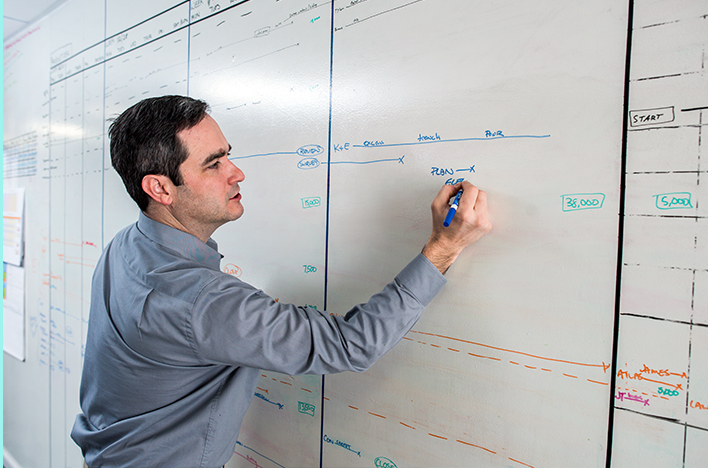Business is booming for local remodeler ReTouch. Here’s how owner Lance McCarthy and his team did it—and how they’re planning for an even brighter future.
Drive down the streets of Fairway, Prairie Village or Leawood, and there’s a good chance you can spot one of the gorgeous home expansion or remodeling projects completed by ReTouch Design-Build-Renovate. The Overland Park-based contractor has become the go-to choice for people who want to reinvest in their houses.
| ENTREPRENEUR Lance McCarthyCOMPANY INFORMATION ReTouch Build-Design-Renovate 6025 Metcalf Lane, Ste. 310 Overland Park, KS 66202 (913) 871-9344 www.retouchco.com YEAR FOUNDED EMPLOYEES |
Business hasn’t merely been good for ReTouch— it’s been exceptional. Owner Lance McCarthy describes it as being a little like “Wile E. Coyote on rocket shoes.”
Over the course of three years, ReTouch grew its revenues by 191 percent, to $3.1 million in 2014. McCarthy added four new employees, nearly doubling his head count, but it’s been a challenge to keep up with customer demand.
That’s the thing about rocket shoes: It’s fun to go fast … if you can stay in control.
“Because you’re going,” McCarthy said, “and it’s not completely under your control always.”
Not only has McCarthy learned how to manage a fast-growing business, he’s also taken steps that should position ReTouch for even bigger success down the line.
And McCarthy is all about the long term.
“Some people do remodels and things just to get square footage or pump ROI or some other goals,” McCarthy said. “We’re really good at helping people make spaces that live really well for a long period of time.”
Clients for Life
ReTouch officially opened in 2003, but McCarthy has been in construction much longer.
He started his first business, a deck-building operation, when he was a teenager at Shawnee Mission West. To pay for his education degree at Kansas State University, he installed decks and flipped houses. And that doesn’t count the work he did for a string of other contractors along the way.
After graduation, he taught English at Sumner Academy in Kansas City, Kan., but continued renovating houses as a sideline. Teaching “was a blast,” he said, but following four years in the classroom, he decided to go into business for himself full time.
ReTouch’s original niche was slightly different from what it is today. McCarthy wanted to help homeowners spruce up their homes so that, when they put those properties on the market, they could command a higher selling price.
“I thought, you know, if you could create a service that helped people prepare their own houses for sale, like a flipper does, these homeowners could realize all this latent profit basically just sitting in their houses,” McCarthy said.
It was a good idea, and ReTouch’s approach delivered excellent results for those who used it. But it was tough finding clients who fit that exact profile.
“People don’t say, ‘I’m going to list my house, I better call a guy who can help me get my house ready for sale,’” McCarthy said. “So we had trouble getting that type of business, but people just kept asking us to do other things.”
Today, ReTouch primarily serves clients who plan to stay in their homes. The company also provides tenant finishes for commercial spaces, which accounts for a third of ReTouch’s workload. There’s even the very occasional custom home build.
ReTouch serves the entire Kansas City metro, but most of its jobs center on Johnson County.
“People don’t want to move out of those neighborhoods,” McCarthy said, “but the old house just doesn’t work for them anymore.”
Instead of helping home-owners get ready for a sale—a relatively quick interaction—ReTouch aims to build lasting relationships with clients, who keep coming back to them.
“We built this idea of wanting to create clients for life,” McCarthy said. “So every time we did a job, the goal was to make sure we made them and everyone they know want to work with us.”
What ReTouch Does Differently
There are a few other things that McCarthy and ReTouch do that set them apart.
First, at the start of a project, they devote more time to talking to clients about what they want, more than the average contractor might. This allows ReTouch to form a clearer picture of customers’ expectations—and how to achieve them inside the customers’ budget.
“That’s really our trademark or secret sauce, I guess you’d call it,” McCarthy said. “I think a lot of people jump into the actual construction fairly quickly and then start discovering all these surprises, like, ‘Oh, that’s not the tile I wanted,’ or all these things and the price starts swinging all over the place.
“We’ve tried to flip that process so we do a lot more discovery up front.”
The other difference: ReTouch avoids competitive bidding. For a typical remodeling project, a homeowner might request proposals from three or four companies, then hire whoever offered the lowest price—even if a different contractor would deliver a better product.
Putting together the bids “takes a lot of work, and it doesn’t usually give the client what they want,” McCarthy said. “So, as we started to create this collaborative design process that really requires people to engage in a relationship pretty early, they’re more likely to get what they want.”
This also requires ReTouch to spend more time on marketing, to make sure that it has a pipeline of ideal clients. The best customers tend to be professionals or business owners who can take a longer view.
“A lot of it is demeanor,” McCarthy said. “People who enjoy a collaborative process and who want to make their spaces work better than they do now.”
McCarthy’s first clients were friends of friends. Repeat customers have helped, too. ReTouch also has found success with social media and content marketing.
McCarthy writes a weekly blog post on remodeling for the Prairie Village Post, the local news website that covers one of ReTouch’s busiest markets. His team posts photos and videos of their work on Facebook and YouTube five or six times a week.
It’s not enough to pen a blog post once a quarter, he said. Outreach must be a regular effort.
“It’s not sexy, and it probably took two years before any of that started paying off,” McCarthy said. Today, though, “we get several calls a week from social media. … For a company our size, that’s pretty good.”
At first, ReTouch tried to tackle practically every piece of business that came its way, but McCarthy realized he had to be more selective, until the company’s capacity could expand to accommodate those new projects
“One of the hazards that we noticed of our fast growth was the strain it put on the most important element of our company—or any company, in my opinion—which is continuing to produce the highest possible quality product,” McCarthy said.
“That was something that became much harder the faster we grew. We decided that, moving forward, we have to make sure we limit our growth by our ability to provide something of quality, which for us is a space that will last for decades.”
No Time for Hammers
It’s been about six years since Lance McCarthy swung a hammer as a regular part of his day. Most of his mornings are spent on calls with clients and meetings with architects and designers. He also directly manages at least one remodel at a time, so he checks in at his teams’ jobsites regularly.
“I was a guy who loved having a hammer in his hand, who thought that that was the same thing as being good at running a company in construction,” McCarthy said. “For the last decade now, I’ve been working to become good at the business side.”
He joined the Helzberg Entrepreneurial Mentoring Program. His mentor, Mike O’Malley, helped McCarthy develop a better understanding of his company’s finances and put together a system of reports and controls.
“The financial controls have been tremendously helpful,” McCarthy said. “I don’t think I would still be in business without that set of resources.”
McCarthy also created systems for ReTouch’s jobs. His crews follow a set of checklists and procedures for each project, and those lists are cloud-based, so McCarthy and other team members can check a job’s progress from anywhere, at any time.
He has formed “cells”—specialized teams that collaborate on similar kinds of projects. One cell might focus on full-scale home remodels while others deal with one-room jobs or basic service calls.
“I think the remodeling and construction industry is about two decades behind the times,” McCarthy said. “There’s going to have to be a major shift in how our industry works in the next decade. Because as technology grows and the complexity of the work we do, you just simply can’t work like you did before.”
Falling Rain and Heart Surgery
McCarthy and his wife always dreamed about moving to Seattle because they love the weather there. And now?
“I stopped enjoying rain,” McCarthy said. “Rain costs money. I’ll wake up in the middle of the night if I hear rain and immediately tick off the projects in my head to see if any of them are potentially in trouble.
“Because what we do is like open heart surgery on a house. There’s this point in time where the body, or the house, is in incredible risk, and there’s a part of that risk that you can’t do anything about. You’re just kind of at the mercy of fate.”
But it’s worth it, simply to create a home that customers can enjoy for decades.
“I absolutely love what I’m doing now,” he said. “Really, the challenge of building a company and trying to make it better and better at giving people what they want is so exciting.”
(photos by Dan Videtich)




